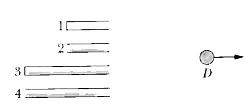Figure shows four tubes with lengths 1.0 m or 2.0 m, with one or two open ends as drawn. The fifth harmonic is set up in each tube, and some of the sound that escapes from them is detected by detector D, which moves directly away from the tubes. In terms of the speed of sound v, what speed must the detector have such that the detected frequency of the sound from (a) tube 1, (b) tube 2, (c) tube 3, and (d) tube 4 is equal to the tube's fundamental frequency?

(a)0.80v,(b)0.80v,(c)0.80v,(d)2v/3
Topper's Solved these Questions
- WAVE - IIBook:RESNICK AND HALLIDAYChapter:WAVE - IIExercise:PRACTICE QUESTIONS (SINGLE CORRECT CHOICE TYPE)
Explore 35 Videos
- WAVE - IIBook:RESNICK AND HALLIDAYChapter:WAVE - IIExercise:PRACTICE QUESTIONS (MORE THAN ONE CORRECT CHOICE TYPE)
Explore 6 Videos
- WAVE - IIBook:RESNICK AND HALLIDAYChapter:WAVE - IIExercise:CHECKPOINTS
Explore 4 Videos
- VECTORS Book:RESNICK AND HALLIDAYChapter:VECTORS Exercise:PRACTICE QUESTIONS
Explore 39 Videos
- WAVES-IBook:RESNICK AND HALLIDAYChapter:WAVES-IExercise:Practice Questions (Integer Type)
Explore 4 Videos
Similar Questions
A source and a detector move away from each other, each with a speed of 10 m/s with respect to ground with no wind. If the detector detects a frequency 1650 Hz of the sound coming from the source, what is the original frequency of the source? (speed of sound = 340 m/s
View SolutionA source and a detector move away from each other, each with a speed of 10ms−1 with respect to the ground with no wind. If the detector detects a frequency 1950 Hz of the sound coming from the source, what is the original frequency of the source? Speed of sound in air =340ms−1.
View SolutionA source and a detector moveaway fro each other, each with a speed of 10ms−1 with respect to the grond with no wind. If the detector detects a frequency 1950 Hz of the sound coming from thesorce, what is the original frequency of the source? Speed of sound in air =340ms−1.
View SolutionWeak background noises from a room set up the fundamental standing wave in a cardboard tube of length L = 67.0 cm with two open ends. Assume that the speed of sound in the air within the tube is 343 m/s. (a) What frequency do you hear from the tube? (b) If you jam your ear against one end of the tube, what fundamental frequency do you hear from the tube?
View SolutionIn a Quinck's experiment , the sound intensity being detected at an appropriate point , changes from minimum for the second time , when the slidable tube is drawn apart by 9.0cm. If the speed of sound in air be 336m/s, then what is the frequency of this sounding source ?
View SolutionIn a Quinck's experiment , the sound intensity being detected at an appropriate point , changes from minimum for the second time , when the slide able tube is drawn apart by 9.0cm. If the speed of sound in air be 336m/s, then what is the frequency of this sounding source ?
View SolutionA whistle 'S' of frequency v revolves in a circle of radius R at a constant speed v. what is the ratio of the largest and smallest frequency detected by a detector D, at rest, at a distance 2 R from the centre of the circle as shown in the figure? (take speed of sound in air as c)

View SolutionA whistle 'S' of frequency v revolves in a circle of radius R at a constant speed v. what is the ratio of the largest and smallest frequency detected by a detector D, at rest, at a distance 2 R from the centre of the circle as shown in the figure? (take speed of sound in air as c)

View SolutionFigure 7.20 shows a tube structure in which signal is sent from one end and is received at the other end . The frequency of the sound source can be varied electronically between 2000→5000Hz. Find the frequencies at which maxima of intensity are detected . The speed of sound in air 340m/s.

View SolutionFigure 7.20 shows a tube structure in which signal is sent from one end and is received at the other end . The frequency of the sound source can be varied electronically between 2000→5000Hz. Find the frequencies at which maxima of intensity are detected . The speed of sound in air 340m/s.

View Solution
